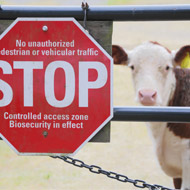New technology provides insights into foot-and-mouth disease

The insight could lead to improved methods for preventing foot-and-mouth disease.
A new understanding of the interaction between foot-and-mouth disease virus (FMDV) and host cells could lead to improved methods for preventing the disease.
The research, supported by The Pirbright Institute, was triggered by advances in cryo-electron microscopy (cryo-EM)1. Unlike other techniques, this technology allows scientists to study samples at very low temperatures and view them in their natural state.
Prior research to view FMDV in such detail revealed an exposed flexible ‘loop’ on the surface of the otherwise smooth outer shell (GH loop). FMDV infects a host cell by binding to a receptor protein on the cell surface called intern via the GH loop.
Up to now, it has been impossible to see the process of engagement due to the integrin binding part being so flexible. Improved imaging techniques have allowed biologists to observe the virus-host cell interaction more effectively and overcome the previous challenge of visualising the flexible attachment site.
“There are seven distinct serotypes of FMDV, but in this study, we focussed on serotype O as it poses the most significant threat globally and is used in around 80 per cent of vaccines,” explained Dr Julian Seago from The Pirbright Institute.
“Using high-resolution cryo-EM we were able to observe that FMDV extends its GH loop up and away from the virus surface to engage the integrin receptor.
“Detailed mapping of the binding mechanisms between FMDV and host cells may ultimately enable the design of new anti-virals capable of inhibiting the virus from entering host cells. Furthermore, our use of cryo-EM in this research would suggest its usefulness in studies of other virus-receptor interactions.”



 The RCVS has announced a new version of its 1CPD mobile app, with enhanced features for veterinary surgeons and veterinary nurses to record their continuing professional development.
The RCVS has announced a new version of its 1CPD mobile app, with enhanced features for veterinary surgeons and veterinary nurses to record their continuing professional development.